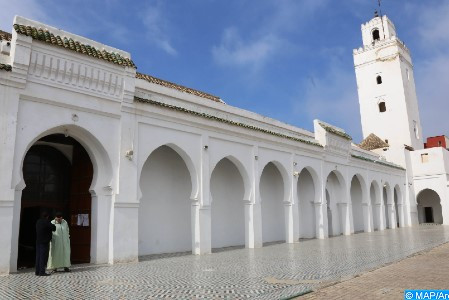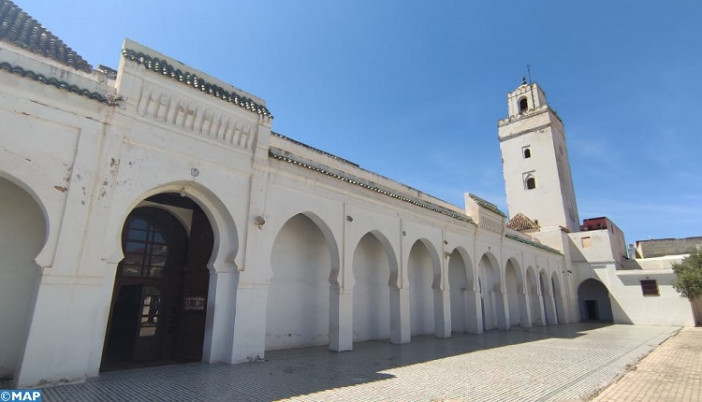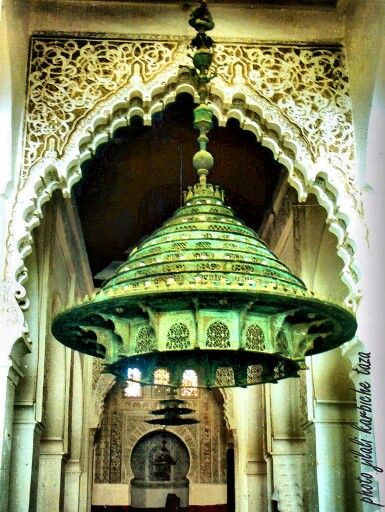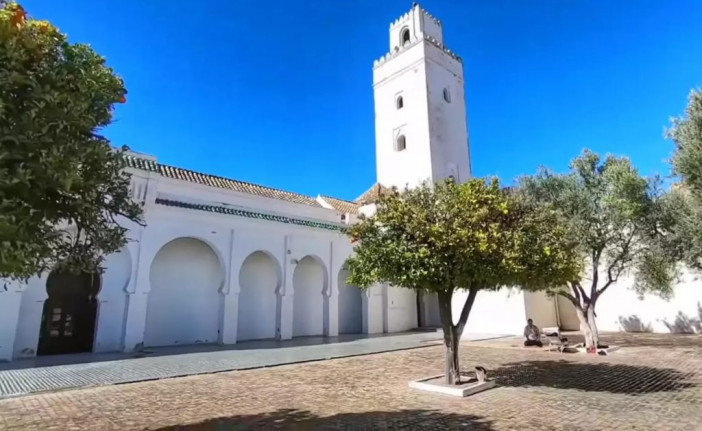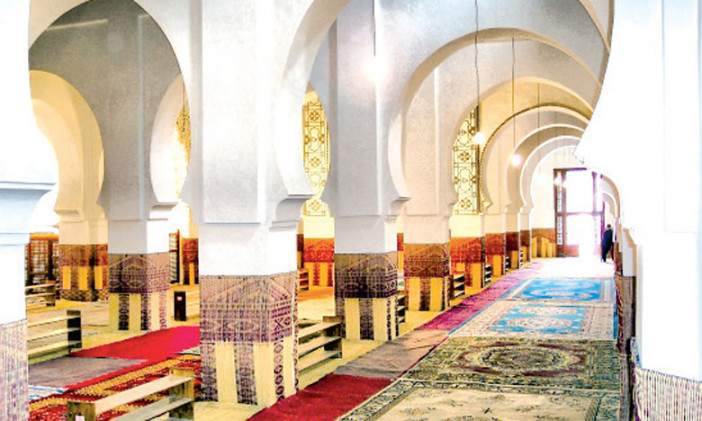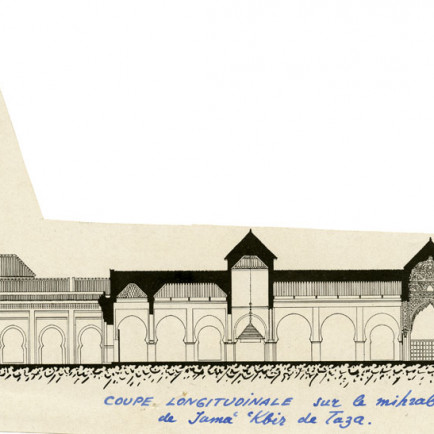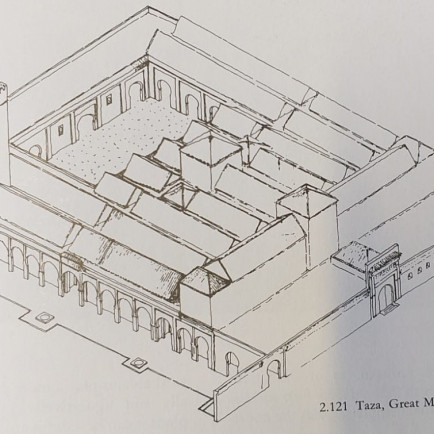The Great Mosque of Taza
History
The Great Mosque of Taza is a mosque in the medina of Taza in Morocco. It was built by the Almohad sultan Abd al-Mu'min in the period after 1142 AD and the walls were completed in 1172. The mosque was enlarged during the reign of the Marinid dynasty in 1292-1293 AD.
Urban and Architectural
Measuring about seventy meters in length and forty meters in width, the great mosque is roughly rectangular in plan and is set slightly off the east-west axis. The main elements of the mosque are a main prayer hall with an interior courtyard (sahn), a large courtyard to the north entered via three doors, an oratory to the west, and a single minaret, situated at the northwest corner of the building. The mosque has nine doors; the main portal is to the east, along the same axis as the mihrab. There are three other street entrances along the western wall. The three doors along the southern wall provide access to the mosque courtyard (sahn al-kabir), while the two doors along the qibla wall lead into the oratory, which is also entered through three doors from Al-Kabir Street to the west.
The main prayer hall is nine bays wide and fourteen bays deep. The bays of the axial nave are wider than the others, and each bay terminates at the aisle preceding the mihrab, giving the mosque a characteristic Maghrebi T-plan configuration. An ornate dome precedes the mihrab. Each bay is covered with wooden gables carried on arches and wooden beams, except for the two bays at either end of the qibla aisle, whose original domes were replaced by wooden vaults.
While the inner Almohad-era courtyard has been preserved, the oratory has since been rebuilt.The mosque opens onto the large southern courtyard with a ten-bay portico, also used for prayer in the summer. The courtyard, with the exception of its walkways, is unpaved. A domed fountain kiosk sits at its center.
Description
The enlargement of the great mosque of Taza was one of the first Marinid building projects. According to inscriptions on the mosque, the sultan Abu Ya'qub Yousef (reg. 1286-1307) nearly doubled the size of the Almohad prayer hall by adding four bays in the direction of the qibla and two bays on the east and west. The Marinid arches are wider than their original Almohad counterparts, and are further distinguished by a rounder horseshoe shape. From the exterior, the Marinid additions are marked by a break in the gabled tiling of the roof.
The bay preceding the mihrab is decorated with intricately carved plaster, and is capped by an ornate Marinid dome with an eight-sided drum carried on lambrequin arches and muqarnas squinches. Triangular windows are located between the squinches. The dome itself is formed of thirty-two interlaced ribs that meet at the apex to form a sixteen-sided star. Between the ribs are pierced epigraphic and arabesque carvings that frame a receding muqarnas disc. The prototype for this intricate dome is believed to be the Almohad dome in the Great Mosque of Tlemcen, dated 1136.The intricately carved stucco mihrab is an octagonal niche framed by a horseshoe arch. To the right of the mihrab is a closet housing the delicate wooden minbar, which typically would be rolled out when needed for Friday sermons. The minbar is of typical Almoravid construction with marquetry decoration in rare wood and ivory.
In the center of the prayer hall, the three bays that marked the mihrab in the original mosque are covered with pyramidal wooden roofs that are supported by arches with elaborate stucco carvings. A conical bronze chandelier, the largest remaining example of its type in North Africa, hangs from the central bay. Composed of nine circular tiers of diminishing size and with a capacity of 512 glass oil lamps, it is adorned with delicately carved epigraphy and arabesques. Its hollow underside mimics the decorative geometry of the Marinid dome in front of the mihrab.
References
https://archiqoo.com/locations/great_mosque_of_taza.php
https://www.wander.am/travel/taza-143681/places/great-mosque-of-taza-193285.en.html
https://en-academic.com/dic.nsf/enwiki/6663031
Details
Location
Taza, Marocco
Worshippers
2000
Owners
The Almohad sultan Abd al-Mu'min
Year of Build
1142
Area
3000
Drawings
Map
History
The Great Mosque of Taza is a mosque in the medina of Taza in Morocco. It was built by the Almohad sultan Abd al-Mu'min in the period after 1142 AD and the walls were completed in 1172. The mosque was enlarged during the reign of the Marinid dynasty in 1292-1293 AD.
Urban and Architectural
Measuring about seventy meters in length and forty meters in width, the great mosque is roughly rectangular in plan and is set slightly off the east-west axis. The main elements of the mosque are a main prayer hall with an interior courtyard (sahn), a large courtyard to the north entered via three doors, an oratory to the west, and a single minaret, situated at the northwest corner of the building. The mosque has nine doors; the main portal is to the east, along the same axis as the mihrab. There are three other street entrances along the western wall. The three doors along the southern wall provide access to the mosque courtyard (sahn al-kabir), while the two doors along the qibla wall lead into the oratory, which is also entered through three doors from Al-Kabir Street to the west.
The main prayer hall is nine bays wide and fourteen bays deep. The bays of the axial nave are wider than the others, and each bay terminates at the aisle preceding the mihrab, giving the mosque a characteristic Maghrebi T-plan configuration. An ornate dome precedes the mihrab. Each bay is covered with wooden gables carried on arches and wooden beams, except for the two bays at either end of the qibla aisle, whose original domes were replaced by wooden vaults.
While the inner Almohad-era courtyard has been preserved, the oratory has since been rebuilt.The mosque opens onto the large southern courtyard with a ten-bay portico, also used for prayer in the summer. The courtyard, with the exception of its walkways, is unpaved. A domed fountain kiosk sits at its center.
Description
The enlargement of the great mosque of Taza was one of the first Marinid building projects. According to inscriptions on the mosque, the sultan Abu Ya'qub Yousef (reg. 1286-1307) nearly doubled the size of the Almohad prayer hall by adding four bays in the direction of the qibla and two bays on the east and west. The Marinid arches are wider than their original Almohad counterparts, and are further distinguished by a rounder horseshoe shape. From the exterior, the Marinid additions are marked by a break in the gabled tiling of the roof.
The bay preceding the mihrab is decorated with intricately carved plaster, and is capped by an ornate Marinid dome with an eight-sided drum carried on lambrequin arches and muqarnas squinches. Triangular windows are located between the squinches. The dome itself is formed of thirty-two interlaced ribs that meet at the apex to form a sixteen-sided star. Between the ribs are pierced epigraphic and arabesque carvings that frame a receding muqarnas disc. The prototype for this intricate dome is believed to be the Almohad dome in the Great Mosque of Tlemcen, dated 1136.The intricately carved stucco mihrab is an octagonal niche framed by a horseshoe arch. To the right of the mihrab is a closet housing the delicate wooden minbar, which typically would be rolled out when needed for Friday sermons. The minbar is of typical Almoravid construction with marquetry decoration in rare wood and ivory.
In the center of the prayer hall, the three bays that marked the mihrab in the original mosque are covered with pyramidal wooden roofs that are supported by arches with elaborate stucco carvings. A conical bronze chandelier, the largest remaining example of its type in North Africa, hangs from the central bay. Composed of nine circular tiers of diminishing size and with a capacity of 512 glass oil lamps, it is adorned with delicately carved epigraphy and arabesques. Its hollow underside mimics the decorative geometry of the Marinid dome in front of the mihrab.


